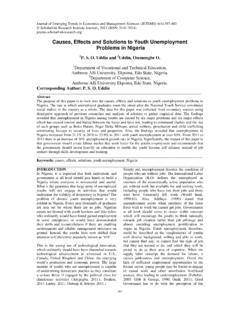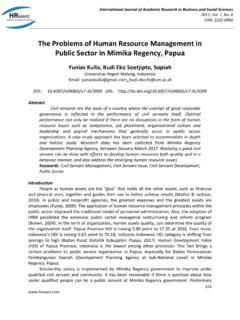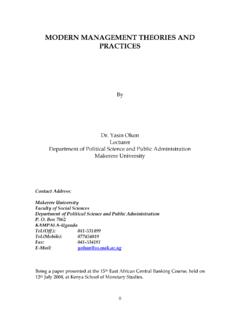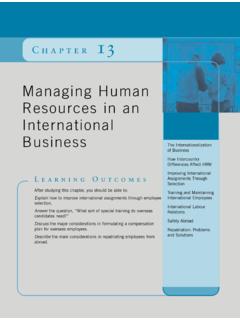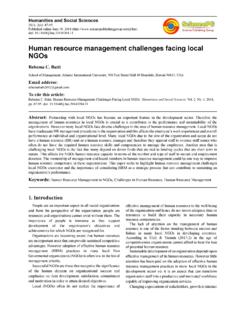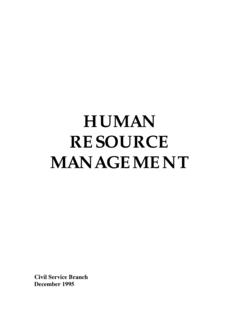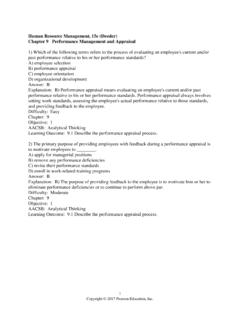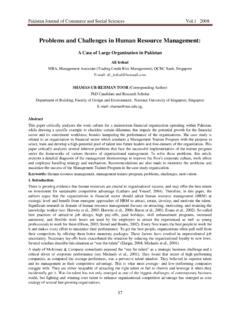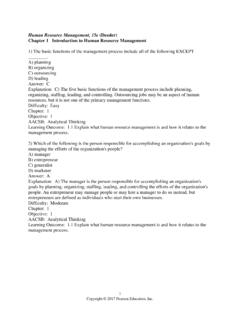Transcription of Human Resource Planning: A Key Factor in …
1 Journal of Emerging Trends in Economics and management Sciences (JETEMS) 4(4):388-396 (ISSN: 2141-7016) 388 Human Resource planning : A Key Factor in Ensuring the Effectiveness and Efficiency of Organization Omoankhanlen Joseph Akhigbe Department of management , Faculty of management Sciences, University of Port Harcourt Nigeria. _____ Abstract This paper investigates the relative influence of Human Resource planning (HRP) on the effectiveness and efficiency of organization. Effectiveness being the degree to which the organization is successful in achieving strategy, mission, and vision. Efficiency being how well the organization uses its resources (financial, Human , physical, information). The paper is of the view that organizations being institutions are established to accomplish specified goals. To achieve these goals, the Human Resource planning is seen as one of the most crucial factors , without which the goals are as good as dead.
2 The study recommended that HRP should be a priority in every organization, since it has impact on organizational performance. _____ Keywords: Human Resource planning , effectiveness, efficiency. INTRODUCTION Despite the efforts made by organizations to ensure that there are right people, in the right place, at the right time, there are still some challenges in the whole process of implementation of effective Human Resources planning in organizations. Failing to properly plan for their Human resources, employers are forced to become reactive, rather than proactive. This tendency of reactiveness causes problems of rush recruitment which sometimes led to wrong recruitments. What is popularly known as Human Resource planning was formally called manpower planning prior to late 1970s. The usage of manpower planning was appropriate them, since it was the era of personnel management .
3 However, in the early 1980s, the term Human Resource in place of manpower planning gained acceptance as a way of emphasizing the positive view of Human Resource in line with Human resources management concept. The efficiency and effectiveness of organizations depend, to a great extent, on effective Human Resource planning . Effective Human Resource planning is a process of analyzing an organization s Human Resource needs under changing conditions and developing the activities necessary to satisfy these needs (Biswajeet 2010:34). With the speedy development of Japanese economy, countries all over the world discovered that the rapid growth of any economy did not lie in attaching single importance to material factors such as the production system. Hence, organizations are realizing that it is imperative to hire employees who can do the job and be successful at it.
4 It behooves the organization to find these people, bring them into the organization and maintain their services. This requires HRP and implementation. It is unfortunate that many organizations had to suffer due to improper HRP. Today s organizations can no longer just hire to hire or can no longer rest on the belief that individuals will stay with the organization through thick and thin (Decenzo & Robbins 1998:91). STATEMENT OF RESEARCH problem Managing Human resources is primarily a line activity, yet the line managers being operating managers are more concerned with materials and financial resources than with the Human resources. Human resources are the key to success in organizations. Yet many organizations too often, forget how important the people variable (organization s most valuable asset) is to the success of an organization. Many organizations and managers have failed because they have taken their Human resources for granted.
5 Moreover, many of the ill defined organizational problems tag tough-to-solve Human Resource problems facing organizations could be resolve through effective Human Resource planning . Effective Human Resource planning in the areas of recruitment of employees, retention of staff, utilization of staff, improvement of staff performance and disengagement of staff is a necessity in today s turbulent business world. In all, the major setback in Human Resource planning is the systematic analysis of Human resources on a continuous basis. For this, databanks have to set be set up with all relevant Journal of Emerging Trends in Economics and management Sciences (JETEMS) 4(4):388-396 Scholarlink Research Institute Journals, 2013 (ISSN: 2141-7024) Journal of Emerging Trends in Economics and management Sciences (JETEMS) 4(4):388-396 (ISSN: 2141-7016) 389 information to aid HRP decisions. Mostly, HRP decisions are made in organizations in the absence of any clear means of assessing the effects or the relevance of their decisions to the databanks that usually serve as a proper approach to HRP.
6 Naturally, those who take HRP decisions, attempts to take the aforementioned Factor into consideration, but they rarely have the information to do so satisfactorily, most especially when it come to systematic way of storing data and information for each individual employee to aid planning ; decision making; to analyze factors representing change change that potentially affects survival, growth, efficiency, and effectiveness, as well as excellence, productivity and profitability of business; and a host of other HRP issues. From the foregoing, the point made is simple: that the quality of HRP decisions in organizations largely depends upon the quality of information held by it and the key to effective HR planning is proper approach via HRP databanks. In this study, questions that might be investigated include: i. What are the ways organizations can observe proper Human resources planning (HRP) that facilitates other staffing functions of Recruitment, Selection, Placement and Induction?
7 Ii. What are the underlying prescriptions for computing Labour Turnover, Labour Stability Index and Analysis of Leavers by Length of Service? REVIEW OF RELATED LITERATURE Human Resource (HR) planning concept is not new to organizations, but attitudinal behaviours of organizations management are responsible for organizations inability to implement HRP. HR planning looks at broader issues relating to the ways in which people are employed and developed in order to improve organizational effectiveness (Armstrong 2001:357). HR planning is the process for ensuring that the Human Resource requirements of an organization are identified and plans are made for satisfying those requirements. Human Resource planning as the process by which management determines how the organization should move from its current manpower position to its desired position. Through Human Resource planning , management strives to have the right number and the right kinds of people, at the right places, at the right time, doing things which result in both the organization and the individual receiving maximum long-run benefits.
8 Human Resource planning (HRP) is a systematic analysis of HR needs in order to ensure that correct numbers of employees with the necessary skills are available when they are required. Today, more and more organizations are realizing the need for serious Human Resource planning , since Human Resource would prefer the organizations that enable them to fulfill their true potential and, in so doing, help the organizations to achieve their objectives. Conceptually, HR planning should be an integral part of business planning . The strategic planning process should define projected changes in the scale and types of activities carried out by the organization. It should identify the core competencies the organization needs to achieve its goals and, therefore it skills requirements. In as far that there are articulated strategic business plans, HR planning interprets them in terms of people requirements.
9 But it may influence the business strategy by drawing attention to ways in which people could be developed and deployed more effectively to further the achievement of business goals, as well as focusing on any problems that might have to be resolved in order to ensure that the people required will be available and will be capable of making the necessary contribution (Armstrong, 2001:358). HR planning is useful in identifying the knowledge and skills needed to successfully identify Human Resource requirements and attract and retain an effective workforce for an organization. Human Resources planners in organizations need an understanding of how recruitment and selection fits into the broader organizational structure, processes, and goals of an organization and how this function is related to the other functions of Human Resource planning . Human Resource planning has traditionally been used by organizations to ensure that the right person is in the right job at the right time.
10 Human Resource planning is defined as the process of determining the Human Resource needs of organizations in the long-term (De Cenco and Robbins 1996:127). Human resources planning cannot exist in isolation. Therefore, it must be linked to other HRM functions. HR planning is the foundation of staffing; hence, HR planning is a process that identifies current and future Human resources needs for an organization to achieve its goals. It means forecasting an organization s future demand and supply for employees, based on its business needs; and subsequently developing and employing the strategies required to meet these needs. It involves a gap analysis between current HR supply and future demand. Strategies are then developed to address the gap and may involve recruitment, internal staffing, development, training, contracting and partnering, and activities relating to downsizing.
